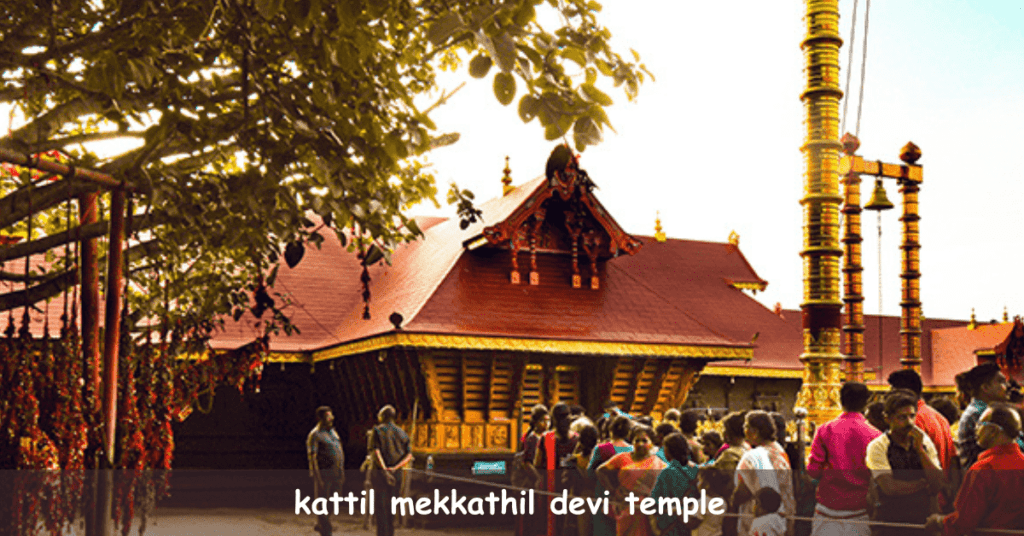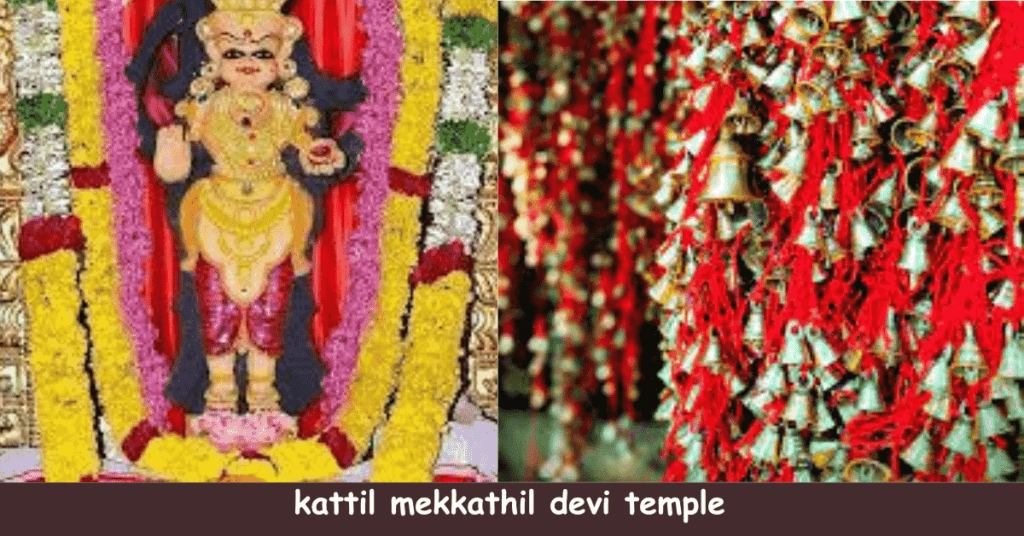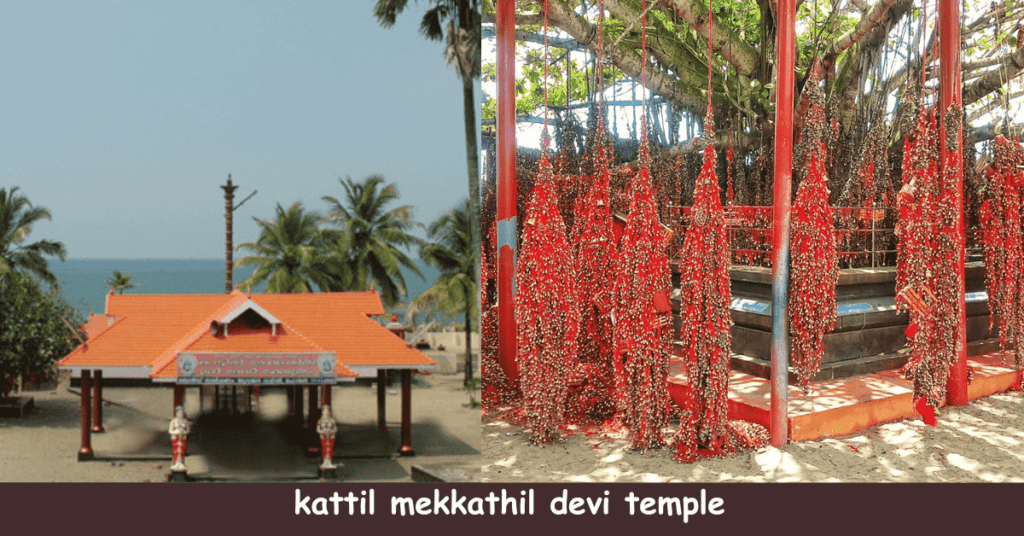Introduction – Kerala, known as “God’s Own Country,” is rich in culture, traditions, and spirituality. Among the numerous temples that adorn this beautiful state, one stands out for its captivating aura and divine significance – Kattil Mekkathil Devi Temple. In the serene surroundings in Kerala, the temple has been a popular place for pilgrims and devotees. In this comprehensive guide, we will delve into the enchanting world of Kattil Mekkathil Devi Temple and explore its history, architecture, rituals, festivals, and spiritual significance.

The Timeless Legacy: Unveiling the Historical Significance of Kattil Mekkathil Devi Temple
The Kattil Mekkathil Devi Temple is a revered testament to Kerala, India’s historical and cultural richness. Nestled amidst the serene backwaters of Alleppey, this ancient temple holds immense historical significance that traces back several centuries.
Based on local legends and historical records, the temple’s origins may be the Chera Dynasty, which thrived from the 9th to 12th centuries of CE. It that the temple was built during this period, making it a witness to over a millennium of history.
One of the striking features of the Kattil Mekkathil Devi Temple is its unique architectural style. The temple showcases a blend of Dravidian and Kerala architectural elements, with intricately carved wooden pillars and walls adorned with colorful murals depicting various mythological tales. This architectural fusion is a testament to the cultural amalgamation that occurred during the historical era when the temple.
Beyond its architectural splendor, the temple holds immense religious and cultural significance for the local community. It is a center of devotion and pilgrimage, attracting thousands of devotees and tourists annually. The annual festival, “Kumbha Bharani,” is a significant highlight of the temple’s religious calendar. During this grand celebration, devotees engage in vibrant processions, traditional music, and dance performances, creating an atmosphere of joy and spirituality.
The temple’s historical significance by its association with the local folklore and legends. It that the temple was a place of refuge and protection during the turbulent times of war and conflict. Through generations, many stories and tales have narrated instances where the divine power of the goddess ensured the safety and well-being of devotees.
Moreover, the Kattil Mekkathil Devi Temple has played a role in preserving the region’s cultural heritage. It has been a hub for various art forms, including Kathakali (classical dance-drama) and Theyyam (ritualistic dance form), performed within the temple premises for centuries. These performances entertain the visitors and keep alive the ancient traditions and customs of the temple.
Kattil Mekkathil Devi Temple is a magnificent architectural marvel repository of historical and cultural significance. Its age-old presence, unique architectural style, religious importance, and association with folklore make it a cherished heritage site that provides a glimpse into the rich tapestry of Kerala’s history and traditions.
Exploring the Architectural Grandeur of Kattil Mekkathil Devi Temple
The Kattil Mekkathil Devi Temple is a mesmerizing testament to the architectural grandeur of Kerala, India. Renowned for its exquisite craftsmanship and unique design, this temple showcases a harmonious blend of Dravidian and Kerala architectural styles, captivating the hearts of visitors from far and wide.
The temple’s architectural brilliance is evident in its intricate façade. The main entrance, adorned with elaborate carvings and sculptures, sets the tone for the magnificence that lies within. The wooden pillars that line the temple’s interior are a true marvel, intricately carved with mythical creatures, deities, and celestial beings, each telling its own story.
The layout of the Kattil Mekkathil Devi Temple follows the traditional Kerala temple architecture, with a series of courtyards and sanctums. The outermost square, known as the Nalambalam, is surrounded by a high wall adorned with mural paintings depicting episodes from Hindu mythology. The sanctum sanctorum, housing the deity of Goddess Bhadrakali, stands at the center, radiating a sense of divinity and reverence.
The roof of the temple is a remarkable sight to behold. Known as the Chuttuambalam, it showcases intricate wooden carvings and gabled roofs with delicate detailing. The traditional sloping roof is adorned with ornamental ridges, known as the Kireedam, adding a touch of regality to the structure. The top also features a series of miniature sculptures depicting gods, goddesses, and mythical creatures, further enhancing its aesthetic appeal.
One of the temple’s most unique features is using a lot of wood. The temple uses teak wood, which not only lends it a warm and rustic ambiance but also showcases the masterful skill of the artisans who carved these intricate designs. The wooden architecture of the Kattil Mekkathil Devi Temple is a true testament to the rich woodworking traditions in Kerala for centuries.
The overall design philosophy of the temple aims to create a harmonious fusion of spirituality, aesthetics, and cultural symbolism. The intricate carvings, vibrant murals, and carefully crafted spaces evoke a sense of divine beauty and tranquility. Each architectural element has a purpose, creating a sacred environment that enhances the spiritual experience of devotees and visitors alike.
The architectural grandeur of the Kattil Mekkathil Devi Temple is a sight to behold. The intricate craftsmanship, intricate carvings, and combination with Dravidian and Kerala architectural styles combine in beautiful architecture. Beyond its religious significance, the temple stands as a testament to the rich architectural heritage of Kerala, leaving visitors spellbound with its timeless beauty.
Sacred Rituals and Offerings: Embracing Devotion at Kattil Mekkathil Devi Temple
At Kattil Mekkathil Devi Temple, sacred rituals and offerings play a central role in the spiritual journey of devotees. These rituals create a profound connection between the worshippers and the divine presence of Goddess Bhadrakali.
The day begins with the temple priests performing the Nirmalya Darshan, removing the previous day’s floral decorations, and offering prayers to cleanse and sanctify the deity. This ritual signifies the renewal of divine energy and invites the devotees to witness the pure form of the goddess.

The most essential practice in the temple is Abhishekam, the sacred bathing ritual for the gods. Devotees can participate by pouring holy water, milk, or other promising substances over the idol while chanting prayers. This act symbolizes purification, devotion, and offering one’s love and reverence to the goddess.
Another revered ritual is the Neyvilakku, where devotees light traditional oil lamps made of clay and offer them before the deity. The flickering flames represent the dispelling of darkness and the illumination of divine wisdom. By providing these lamps, devotees seek the blessings of the goddess for prosperity, happiness, and enlightenment.
The temple also witnesses the sincere practice of Vazhipadu, which involves making specific offerings or performing rituals as a form of gratitude or seeking divine intervention. Devotees can choose from various Vazhipadu offerings, including coconut, flowers, sandalwood paste, ghee, camphor, and fruits. Each offering is symbolic and represents the devotee’s devotion and desires.
During auspicious occasions and festivals, the Kattil Mekkathil Devi Temple comes alive with vibrant and elaborate rituals. One such festival is the annual Kumbha Bharani, celebrated with great pomp and splendor. Devotees participate in lively processions, engage in devotional music and dance performances, and offer special prayers to honor the goddess. The festival serves as a time of communal bonding and spiritual rejuvenation.
Apart from the rituals, the temple encourages devotees to engage in charitable acts to express their devotion. Donations to the temple and contributions towards community welfare are highly valued. Such acts of generosity and service bring blessings and spiritual merit to the devotees.
The Kattil Mekkathil Devi Temple offers a profound spiritual experience through its sacred rituals and offerings. These practices foster a deep connection between the worshippers and the divine, allowing devotees to express their devotion, seek blessings, and find solace. It is an idyllic sanctuary where the ancient tradition, as well as the beliefs of followers, come together to form an atmosphere of sacred development and transcendence.
Divine Festivities: Celebrating Sacred Festivals at Kattil Mekkathil Devi Temple
Kattil Mekkathil Devi Temple is where divine festivities come alive, enveloping devotees and visitors in an aura of spiritual joy and reverence. Throughout the entire time of the year, the temple celebrates a variety of vibrant and holy celebrations that possess a unique significance, giving devotees the chance to express their appreciation and seek the blessings of God.
The annual Kumbha Bharani is one of the most prominent festivals celebrated at Kattil Mekkathil Devi Temple. Held during the Malayalam month of Kumbham (February-March), this festival is a grand spectacle of devotion and cultural extravaganza. The temple premises witness a flurry of activities, with colorful processions, traditional music, and dance performances filling the air. Devotees from far and vast throng to the temple, dressed in formal attire, to offer prayers and seek the blessings of Goddess Bhadrakali.This festival is an occasion for communal bonding in spiritual and physical rejuvenation. It is also a celebration of the vast tradition of the culture of Kerala.
Navaratri is another significant festival observed at the temple, a nine-night celebration dedicated to the goddess. In the month of Kanni (September-October), Navaratri is the performance of traditional dance forms like Dandiya and Garba. The temple comes alive with vibrant decorations, intricate floral arrangements, and the chanting of devotional hymns. Devotees engage in fasting and prayers and participate in the cultural programs organized during the festival. The atmosphere resonates with devotion and the divine presence of Goddess Bhadrakali, as she is in her various forms over the nine auspicious nights.
The temple also celebrates other critical Hindu festivals like Vishu, Thiruvonam, and Makaravilakku. Vishu, the Malayalam New Year, is celebrated with great enthusiasm, where devotees visit the temple to receive the auspicious Vishukkani, a unique arrangement of flowers, fruits, and bright items. Thiruvonam, the grand harvest festival, witnesses the temple adorned with floral decorations and cultural programs showcasing the rich cultural heritage of Kerala. Makaravilakku, celebrated during the Makar Sankranti festival, is when the temple by devotees who come to witness the divine spectacle of the ceremonial lighting of Makara Vilakku atop the sacred Ponnambalamedu.
These festivals at Kattil Mekkathil Devi Temple serve as a reminder of the rich spiritual and cultural legacy of Kerala. They provide a platform for devotees to express their devotion, engage in communal celebrations, and seek blessings from the goddess. The festivities foster a sense of spiritual connection and promote the preservation and propagation of traditional art forms, music, and dance, keeping the region’s cultural heritage alive.
The festivals celebrated at Kattil Mekkathil Devi Temple are a tapestry of devotion, culture, and spirituality. They bring together devotees from diverse backgrounds, creating an ambiance of joy, faith, and reverence. These sacred celebrations serve as a means to express devotion, seek blessings, and celebrate the rich cultural heritage of Kerala, all while enveloped in the divine grace of Goddess Bhadrakali.
What are the special days of Kattil Mekkathil Temple?
The Kattil Mekkathil Temple holds several special days throughout the year, celebrated with great enthusiasm and devotion by its devotees. Here are some of the notable special days observed at the Kattil Mekkathil Temple:
Thiruvonam: Thiruvonam is one of the major festivals celebrated at the Kattil Mekkathil Temple. It falls during Chingam (August-September) according to the Malayalam calendar. The festival commemorates the birth of Lord Krishna and includes various rituals, cultural programs, and a grand feast called “Onam Sadhya.”
Vishu: Vishu is another significant festival observed at the temple. Celebrated in Medam (April-May), it marks the Malayalam New Year. The festival offers Vishukkani, an arrangement of auspicious items, and Vishu Sadya, a traditional feast.
Navratri: Navratri, meaning “nine nights,” is a vibrant and colorful festival celebrated in honor of Goddess Durga. It typically occurs in September or October. During this period, the temple organizes special puja ceremonies, devotional singing, and cultural performances. The festival concludes with Vijayadashami, also known as Dussehra.
Maha Shivaratri: It usually falls in the month of Phalguna (February-March). Devotees observe fasting, offer prayers, and engage in night-long vigils at the temple—the occasion to cleanse one’s sins and bring blessings from Lord Shiva.
Makaravilakku: Makaravilakku is an important event celebrated at the Kattil Mekkathil Temple, coinciding with the Makar Sankranti festival. It occurs in the month of Makaram (January). The festival’s highlight is the lighting of a unique lamp atop Ponnambalamedu, a nearby hill. Pilgrims throng to witness the divine illumination and seek blessings.

These are some notable special days celebrated at the Kattil Mekkathil Temple. It is essential to remember that these celebrations’ precise dates can differ each year, as they are on the Hindu lunar calendar. It is advisable to check the temple’s official calendar or consult with the authorities for accurate dates and further information about specific celebrations.
Conclusion
Kattil Mekkathil Devi Temple is a testament to Kerala’s rich cultural heritage and spiritual traditions. With its captivating history, breathtaking architecture, and profound spiritual ambiance, this temple has rightfully earned its place as a destination in Kerala. Whether seeking spiritual enlightenment, exploring architectural wonders, or immersing oneself in the state’s vibrant culture, Kattil Mekkathil Devi Temple offers an unforgettable journey that leaves an indelible mark on the hearts of visitors.
A visit to Kattil Mekkathil Devi Temple is a transformative experience that blends spirituality, history, and artistry, making it an essential pilgrimage for those seeking a deeper connection with the divine and a greater understanding of Kerala’s cultural heritage.
